Experimental Investigation on the Spray Behaviour of Bluff Body Air-Assisted Atomizer Designs
Abstract
:1. Introduction
2. Materials and Methods
3. Results
3.1. Spray Structure
3.2. Mean Drop Size (SMD)
3.3. Drop Size Distribution (DSD) and Excentricity Plots
3.4. Patternation Technique
4. Conclusions
Author Contributions
Funding
Data Availability Statement
Acknowledgments
Conflicts of Interest
Appendix A
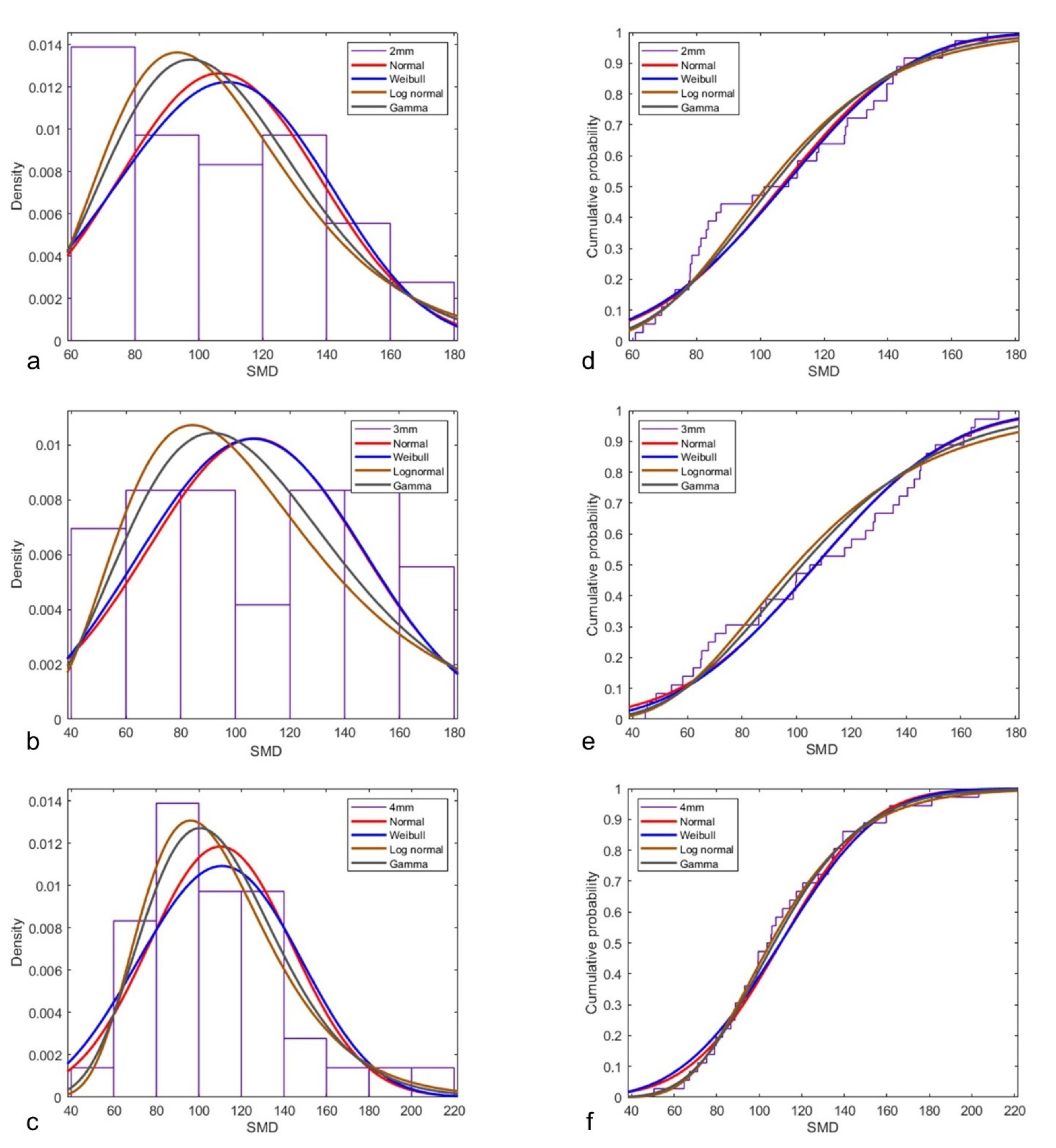
References
- Nasr, G.G.; Yule, A.J.; Bendig, L.G.G. Industrial Sprays and Atomization Design, Analysis and Applications; Springer: London, UK, 2002; ISBN 9781849968751. [Google Scholar]
- Kihm, K.D.; Chigier, N. Effect of Shock Waves on Liquid Atomization of a Two-Dimensional Airblast Atomizer. At. Sprays 1991, 1, 113–136. [Google Scholar] [CrossRef]
- Adiga, K.C.; Willauer, H.D.; Ananth, R.; Williams, F.W. Implications of droplet breakup and formation of ultra fine mist in blast mitigation. Fire Saf. J. 2009, 44, 363–369. [Google Scholar] [CrossRef]
- Chauvin, A.; Jourdan, G.; Daniel, E.; Houas, L.; Tosello, R. Experimental investigation of the propagation of a planar shock wave through a two-phase gas-liquid medium. Phys. Fluids 2011, 23, 113301. [Google Scholar] [CrossRef]
- Borisov, A.A.; Gelfand, B.E.; Natanzon, M.S.; Kossov, O.M. Droplet breakup regimes and criteria for their existence. J. Eng. Phys. 1981, 40, 44–49. [Google Scholar] [CrossRef]
- Issac, K.; Missoum, A.; Drallmeier, J.; Johnston, A. Atomization experiments in a coaxial coflowing Mach 1.5 flow. AIAA J. 1994, 32, 1640–1646. [Google Scholar] [CrossRef]
- Balaji, K.; Sivadas, V.; Radhakrishna, V.; Ashok Bhatija, K.; Sai Charan, K. Experimental Characterization of Intrinsic Properties Associated With Air-Assisted Liquid Jet and Liquid Sheet. J. Fluids Eng. 2018, 140, 051301. [Google Scholar] [CrossRef]
- Leboucher, N.; Laporte, G.; Carreau, J.L. Effect of the inner gas jet on annular liquid sheet atomization. In Proceedings of the 21st ILASS—Europe Meeting, Mugla, Turkey, 10–13 September 2007; pp. 1–5. [Google Scholar]
- Fu, H.; Li, X.; Prociw, L.A.; Hu, T.C.J. Experimental investigation on the breakup of annular liquid sheets in two co-flowing airstreams. In Proceedings of the 1st International Energy Conversion Engineering Conference IECEC, Portsmouth, VA, USA, 17–21 August 2003; pp. 1–11. [Google Scholar] [CrossRef]
- Lee, J.G.; Ghen, L.D. Linear stability analysis of gas-liquid interface. AIAA J. 1991, 29, 1589–1595. [Google Scholar] [CrossRef]
- Mates, S.; Settles, G.S. A study of liquid metal atomization using close-coupled nozzles, part 1: Gas dynamic behavior. At. Sprays 2005, 15, 1–22. [Google Scholar] [CrossRef]
- Mates, S.; Settles, G.S. A study of liquid metal atomization using close-coupled nozzles, part 2: Atomization behavior. At. Sprays 2005, 15, 41–59. [Google Scholar] [CrossRef]
- Fritsching, U. Droplets and particles in sprays: Tailoring particle properties within spray processes. China Particuology 2005, 3, 125–133. [Google Scholar] [CrossRef]
- Kulkarni, A.P.; Deshmukh, D. Spatial Drop-Sizing in Airblast Atomization-An Experimental Study. At. Sprays 2017, 27, 949–961. [Google Scholar] [CrossRef]
- Lefebvre, A.H.; Mcdonell, V.G. Atomization and Sprays, 2nd ed.; CRC Press: New York, NY, USA, 2017; ISBN 9781498736268. [Google Scholar]
- Lovett, J.A.; Mick, W.J. Development of a Swirl and Bluff-body Stabilized Burner for Low-NOx, Lean-Premixed Combustion. In Proceedings of the ASME 1995 International Gas Turbine and Aeroengine Congress and Exposition, Houston, TX, USA, 5–8 June 1995; pp. 1–8. [Google Scholar]
- Bossard, J.A.; Peck, R.E. Droplet size distribution effects in spray combustion. Symp. (Int.) Combust. 1996, 26, 1671–1677. [Google Scholar] [CrossRef]
- Li, X.; Shen, J. Experimental study of sprays from annular liquid jet breakup. J. Propuls. Power 1999, 15, 103–110. [Google Scholar] [CrossRef]
- Leboucher, N.; Roger, F.; Carreau, J.L. Atomization Characteristics of an Annular Liquid Sheet with Inner and Outer Gas Flows. At. Sprays 2014, 24, 1065–1088. [Google Scholar] [CrossRef]
- Choi, C.J.; Lee, S.Y. Drop formation from a thin hollow liquid jet with a core air flow. At. Sprays 2005, 15, 469–487. [Google Scholar] [CrossRef]
- Gullberg, M.; Marklund, M. Spray Characterization of Twin Fluid External Mix Atomization of Pyrolysis Oil. At. Sprays 2012, 22, 897–919. [Google Scholar] [CrossRef]
- Roisman, I.V.; Horvat, K.; Tropea, C. Spray impact: Rim transverse instability initiating fingering and splash, and description of a secondary spray. Phys. Fluids 2006, 18, 102104. [Google Scholar] [CrossRef]
- Yarin, A.L. Drop impact dynamics: Splashing, spreading, receding, bouncing. Annu. Rev. Fluid Mech. 2006, 38, 159–192. [Google Scholar] [CrossRef]
- Josserand, C.; Thoroddsen, S.T. Drop Impact on a Solid Surface. Annu. Rev. Fluid Mech. 2016, 48, 365–391. [Google Scholar] [CrossRef] [Green Version]
- Yarin, A.L.; Roisman, I.V.; Tropea, C. Collision Phenomena in Liquids and Solids; Cambridge University Press: Cambridge, UK, 2017; ISBN 9781316556580. [Google Scholar]
- Bachalo, W.D.; De La Rosa, A.B.; Rudoff, R.C. Diagnostics development for spray characterization in complex turbulent flows. In Proceedings of the ASME, Gas Turbine and Aeroengine Congress and Exposition, Amsterdam, The Netherlands, 6–9 June 1988; Volume 3. [Google Scholar] [CrossRef]
- Rudoff, R.C.; Houser, M.J.; Bachalo, W.D. Experiments on spray interactions in the wake of a bluff body. J. Eng. Gas Turbines Power 1988, 110, 86–93. [Google Scholar] [CrossRef]
- Carrier, D.; De Champlain, A.; Bardon, M.F. Direct fuel injection for bluff body flame stabilization. In Proceedings of the 32nd Joint Propulsion Conference and Exhibit, Lake Buena Vista, FL, USA, 1–3 July 1996; pp. 2–10. [Google Scholar] [CrossRef]
- Eckelmann, H.; Graham, J.M.R.; Huerre, P.; Monkewitz, P.A. Bluff-Body Wakes, Dynamics and Instabilities. In Proceedings of the IUTAM Symposium, Göttingen, Germany, 7–11 September 1992; ISBN 9783662004166. [Google Scholar]
- Batarseh, F.Z.; Gnirß, M.; Roisman, I.V.; Tropea, C. Fluctuations of a spray generated by an airblast atomizer. Exp. Fluids 2009, 46, 1081–1091. [Google Scholar] [CrossRef]
- Sivathanu, Y.; Lim, J. Optical and Mechanical Patternation of an High Flow Rate Industrial Gas Turbine Nozzle. In Proceedings of the ILASS Americas, 21th Annual Conference on Liquid Atomization and Spray Systems, Orlando, FL, USA, 18–21 May 2008. [Google Scholar]
- Roth, A.; Frantz, D.; Chaze, W.; Corber, A.; Berrocal, E. High-speed imaging database of water jet disintegration Part I: Quantitative imaging using liquid laser-induced fluorescence. Int. J. Multiph. Flow 2021, 145, 103641. [Google Scholar] [CrossRef]
- Tate, R.W. Equipment and Design—Spray Patternation. Ind. Eng. Chem. 1960, 52, 49A–58A. [Google Scholar] [CrossRef]
- Jain, M.; Kandar, T.K.; Vhora, S.F.; Iyer, K.N.; Prabhu, S.V. Experimental investigation of the 700 MW e Containment Spray nozzles/System. At. Sprays 2017, 27, 665–690. [Google Scholar] [CrossRef]
- Jordan, S.J.; Ryder, N.L.; Repcik, J.; Marshall, A.W. Spatially-resolved spray measurements and their implications. Fire Saf. J. 2017, 91, 723–729. [Google Scholar] [CrossRef]
- Shrigondekar, H.; Chowdhury, A.; Prabhu, S.V. Performance of water mist system with base injection in extinguishing small container fires. J. Loss Prev. Process Ind. 2021, 71, 104448. [Google Scholar] [CrossRef]
- Cohen, J.M.; Rosfjord, T.J. Spray patternation at high pressure. J. Propuls. Power 1991, 7, 481–487. [Google Scholar] [CrossRef]
- Sikka, R.; Vågsæther, K.; Bjerketvedt, D.; Lundberg, J. Atomization characteristics of a bluff body-assisted sonic twin-fluid atomizer. Int. J. Spray Combust. Dyn. 2022. [Google Scholar] [CrossRef]
- Padwal, M.B.; Jejurkar, S.Y.; Mishra, D.P. Experimental studies on bluff body-assisted airblast atomizer. At. Sprays 2016, 26, 1127–1150. [Google Scholar] [CrossRef]
- Chen, B.; Gao, D.; Li, Y.; Chen, C.; Yuan, X.; Wang, Z.; Sun, P. Investigation of the droplet characteristics and size distribution during the collaborative atomization process of a twin-fluid nozzle. Int. J. Adv. Manuf. Technol. 2020, 107, 1625–1639. [Google Scholar] [CrossRef]
- Sikka, R.; Bjerketvedt, D.; Lundberg, J.; Va, K. Visualization study of annular sheet breakup dynamics in sonic twin-fluid atomizers. J. Vis. 2022, 25, 713–725. [Google Scholar] [CrossRef]
- Liepmann, H.W.; Roshko, A. Elements of Gas Dynamics, 2001st ed.; Dover Publications: New York, NY, USA, 2001. [Google Scholar]
- Schneider, C.A.; Rasband, W.S.; Eliceiri, K.W. NIH Image to ImageJ: 25 years of image analysis. Nat. Methods 2012, 9, 671–675. [Google Scholar] [CrossRef]
- Kowalczuk, P.B.; Drzymala, J. Physical meaning of the Sauter mean diameter of spherical particulate matter. Part. Sci. Technol. 2016, 34, 645–647. [Google Scholar] [CrossRef]
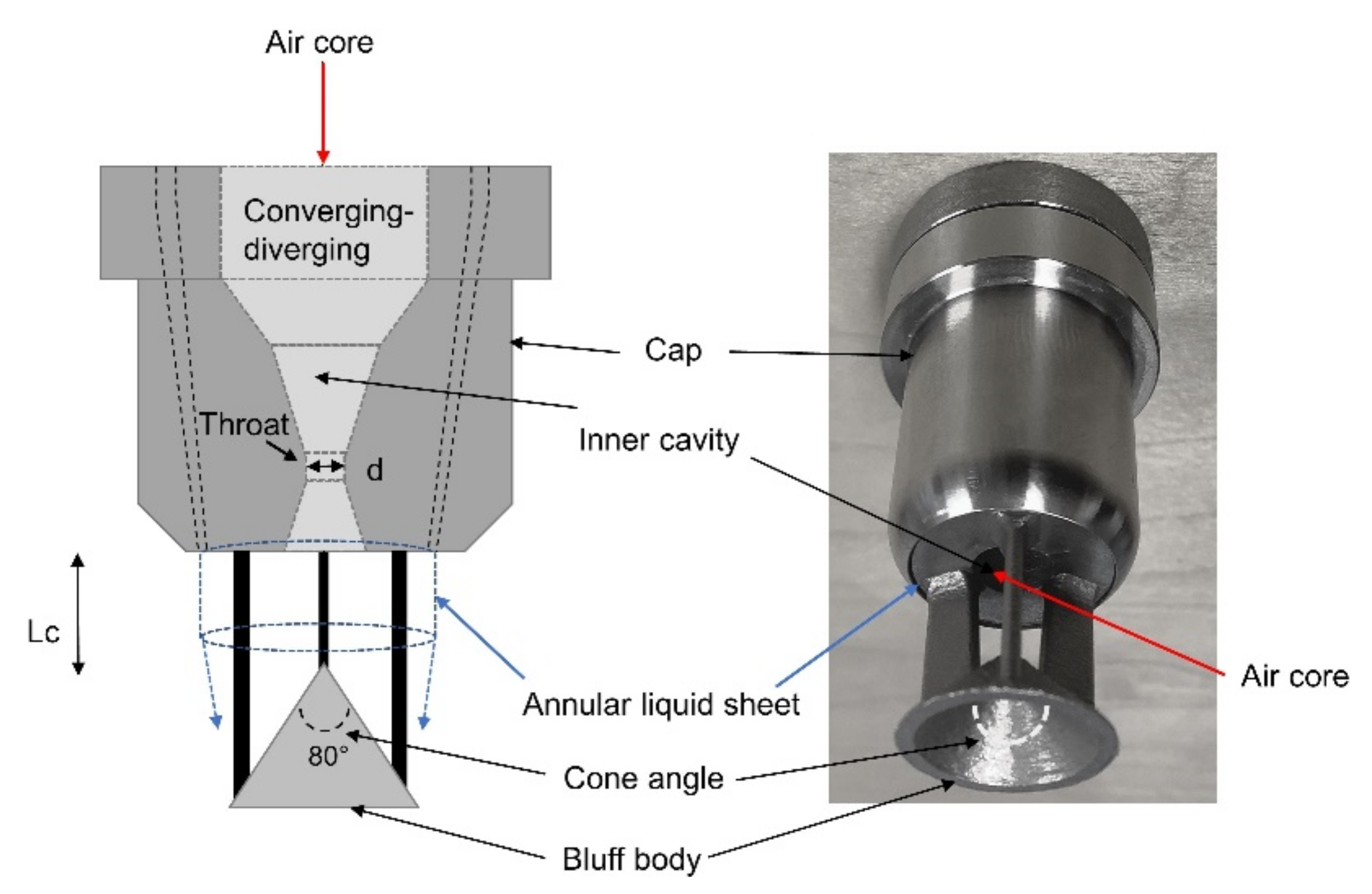
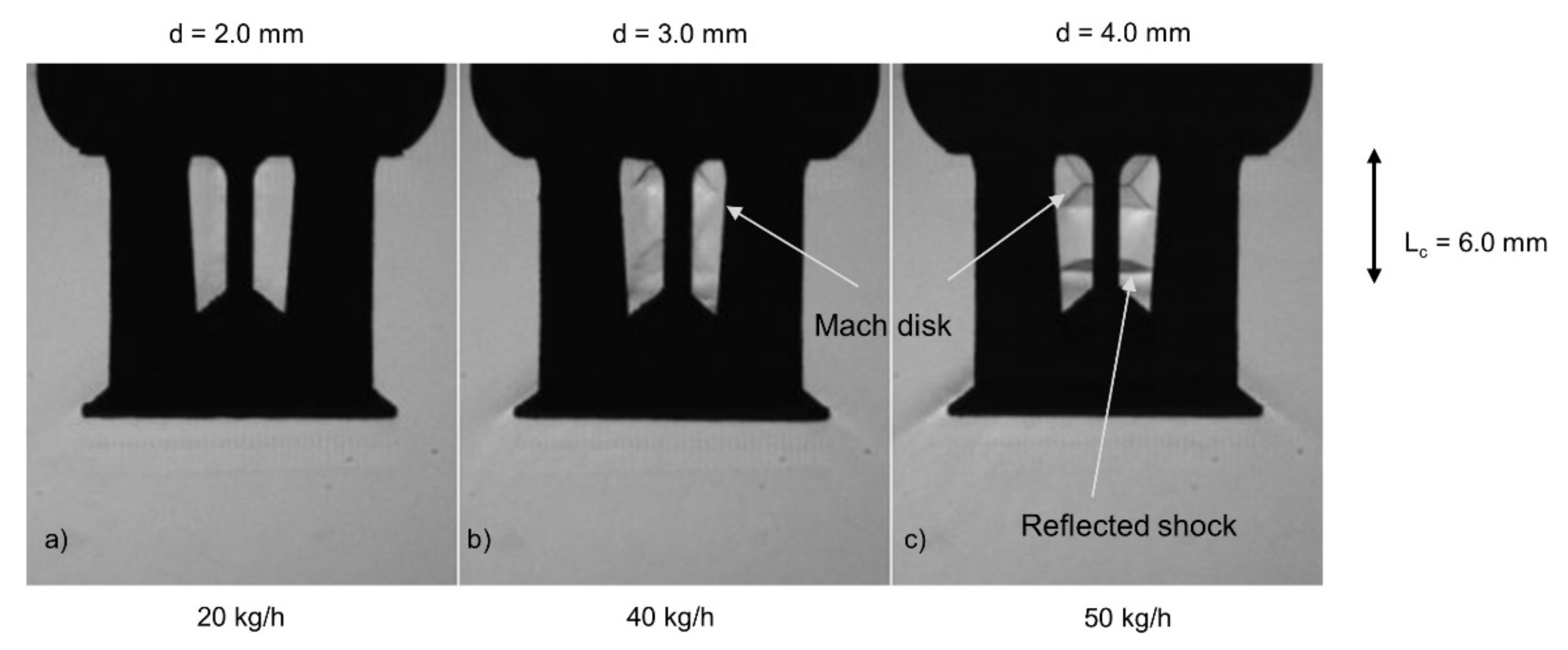
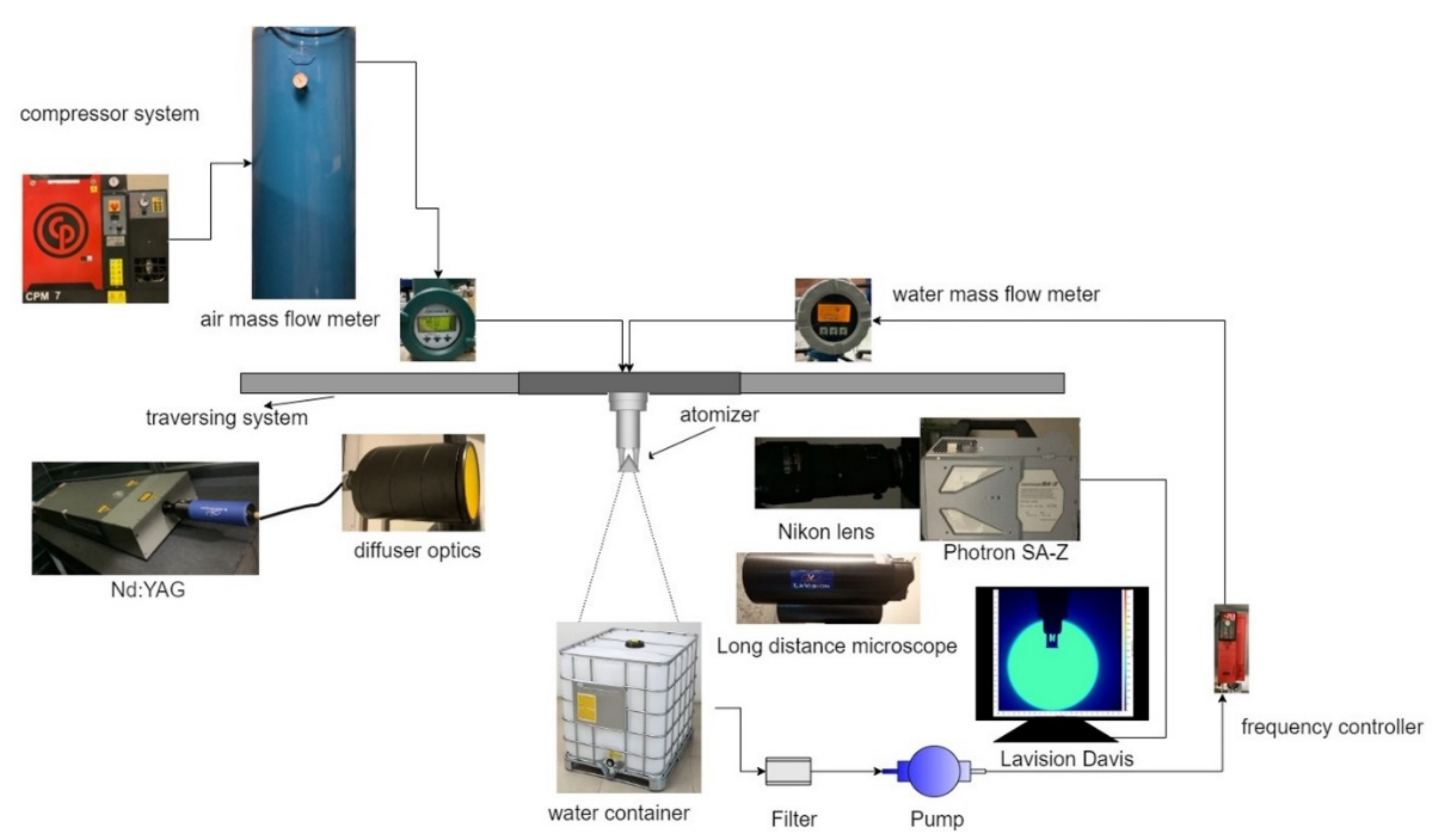
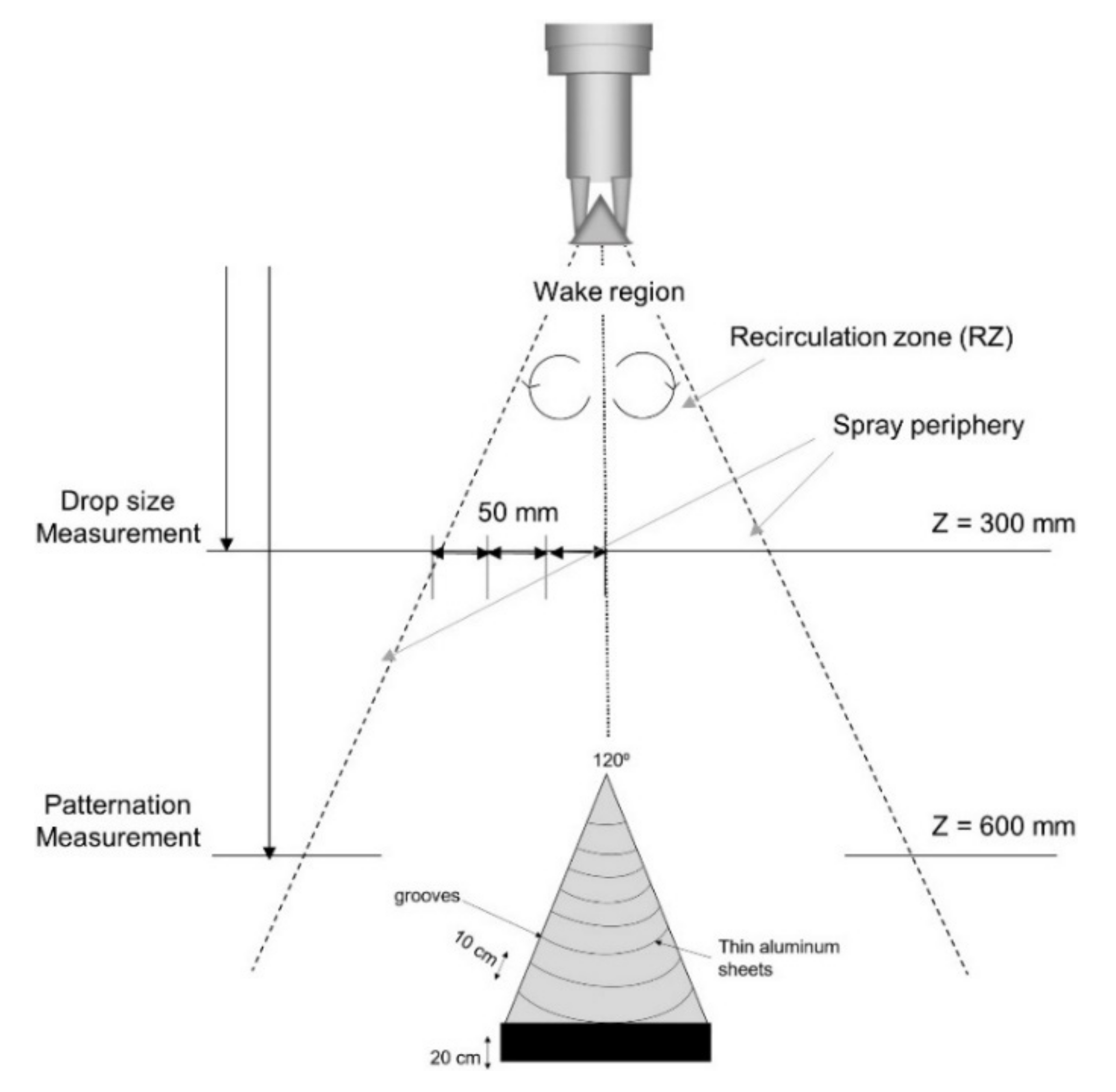
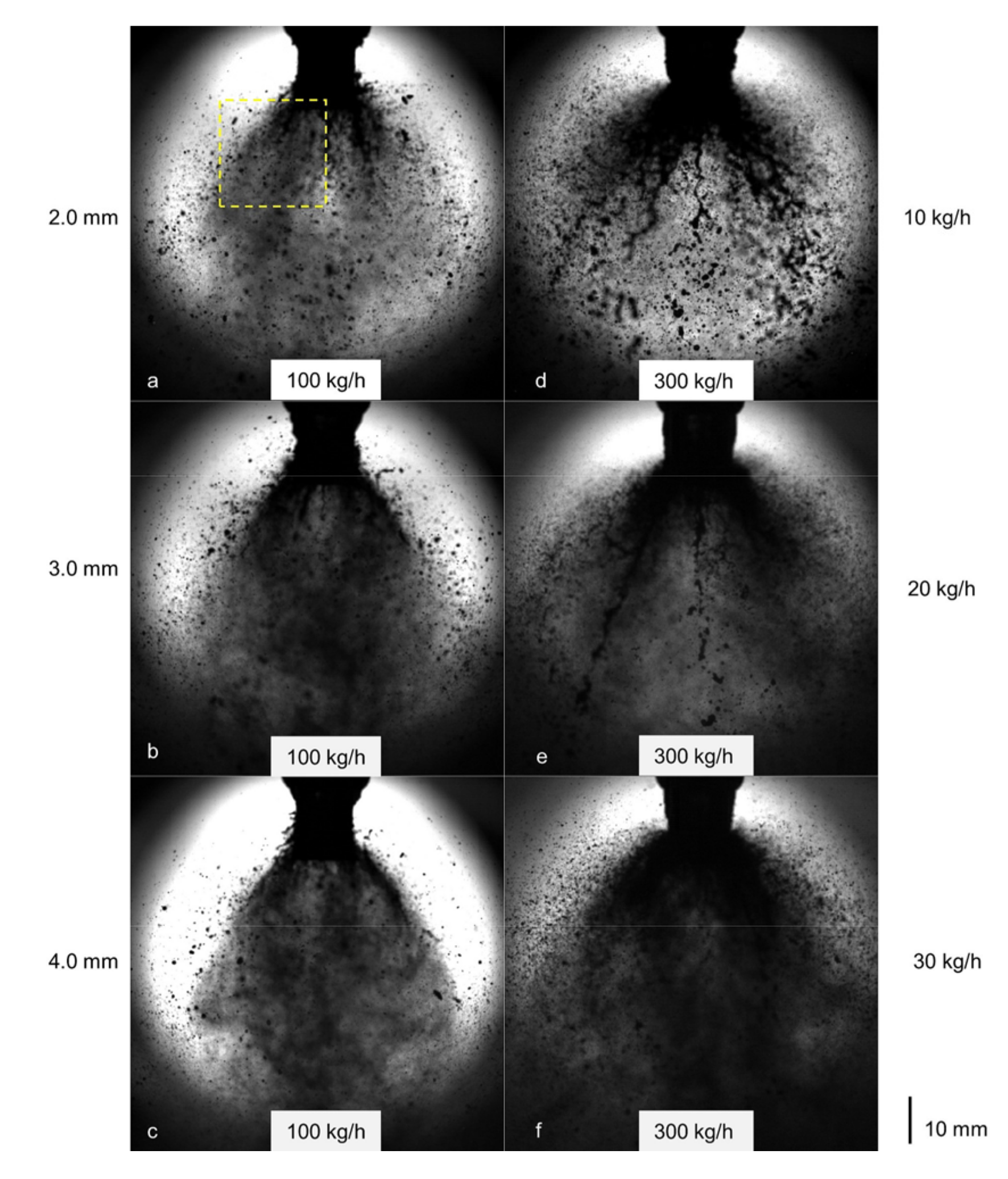


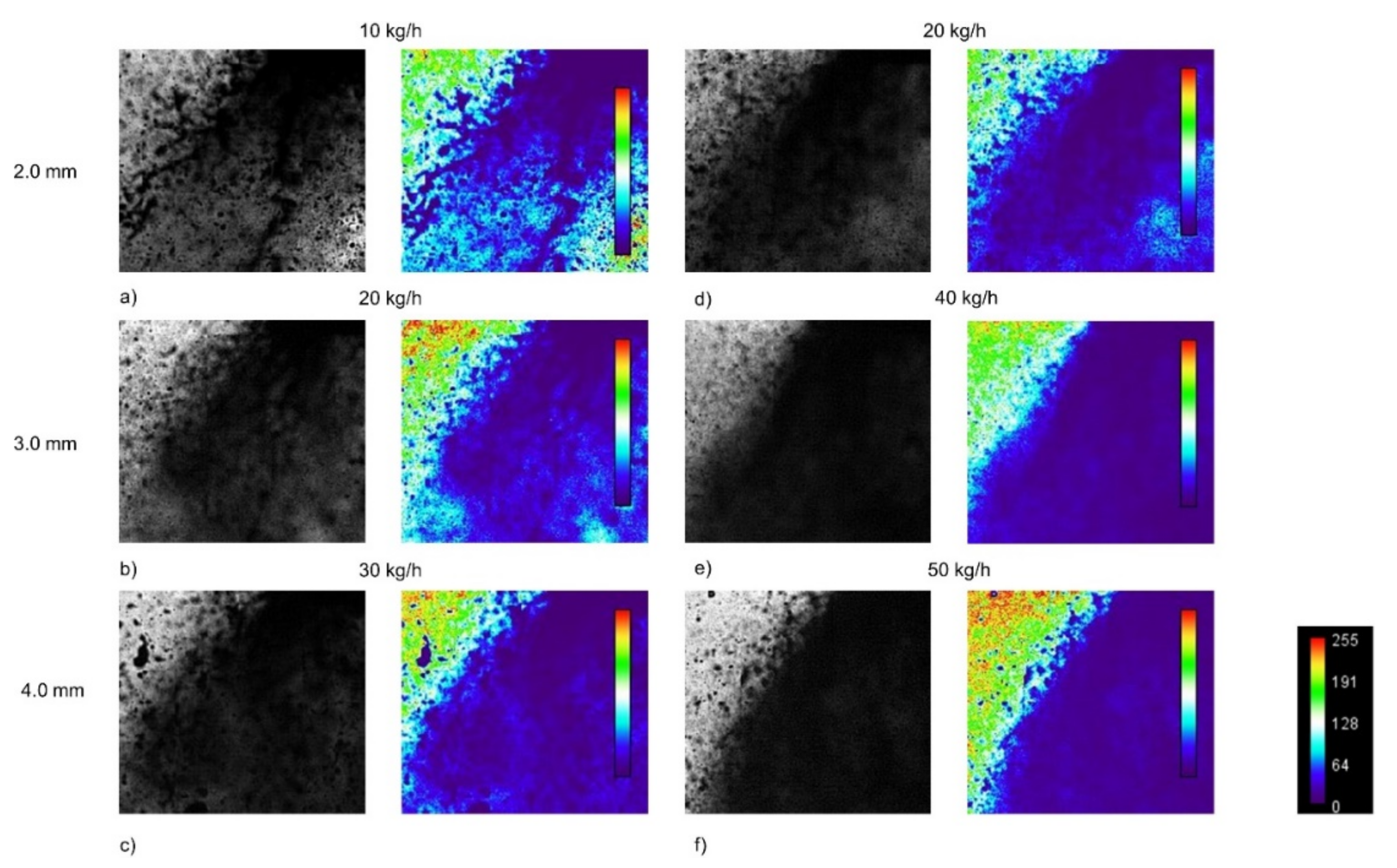
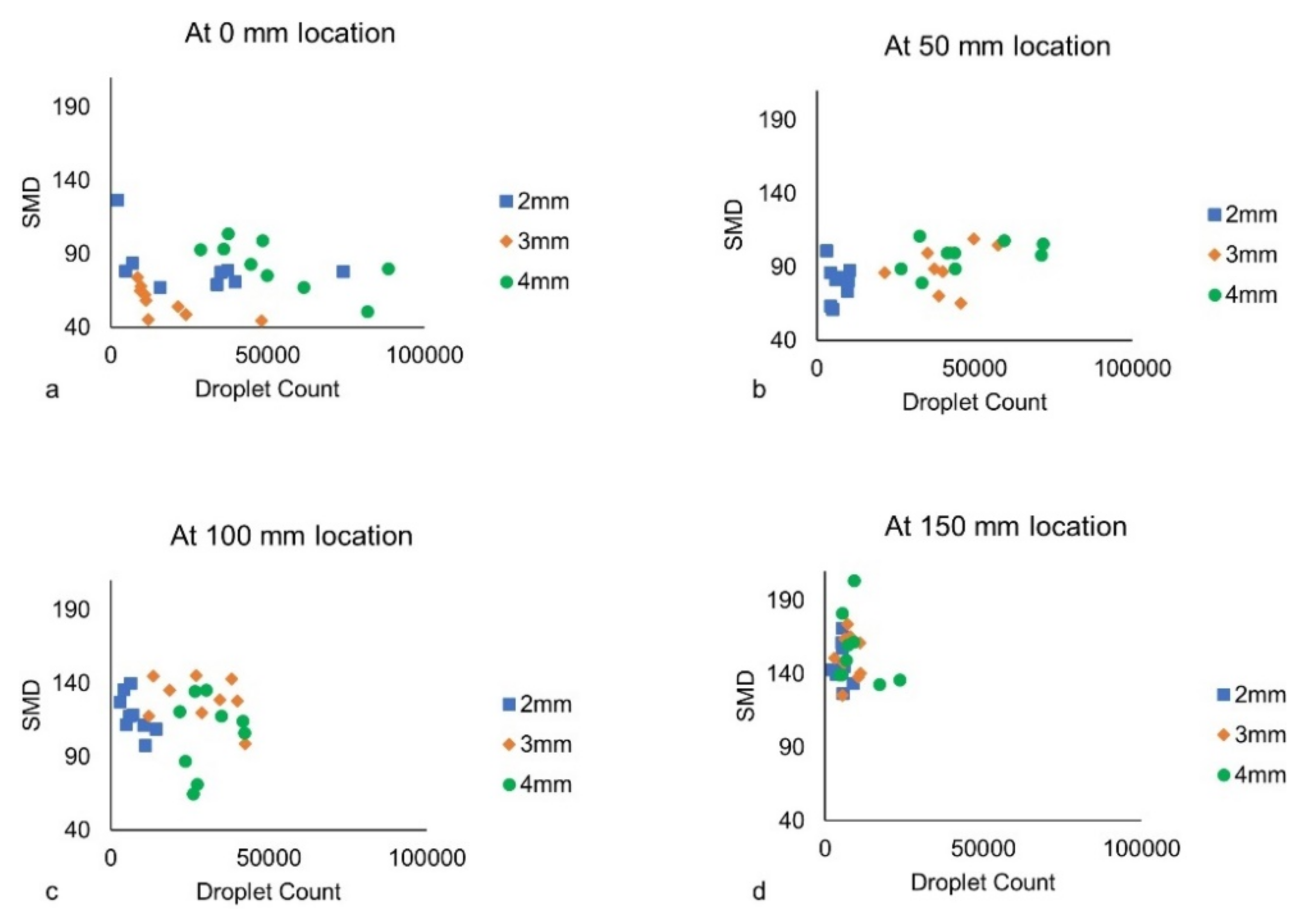



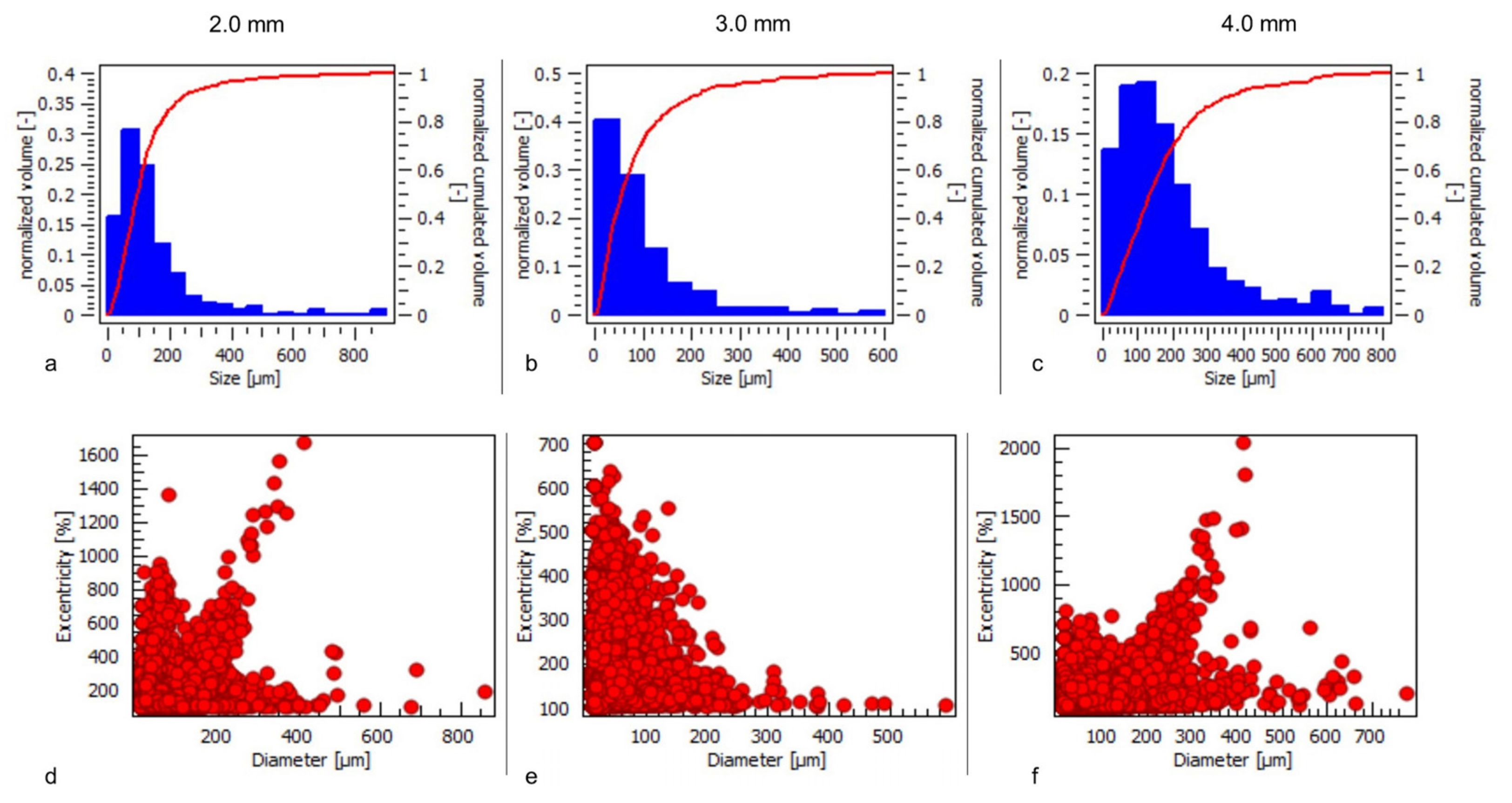


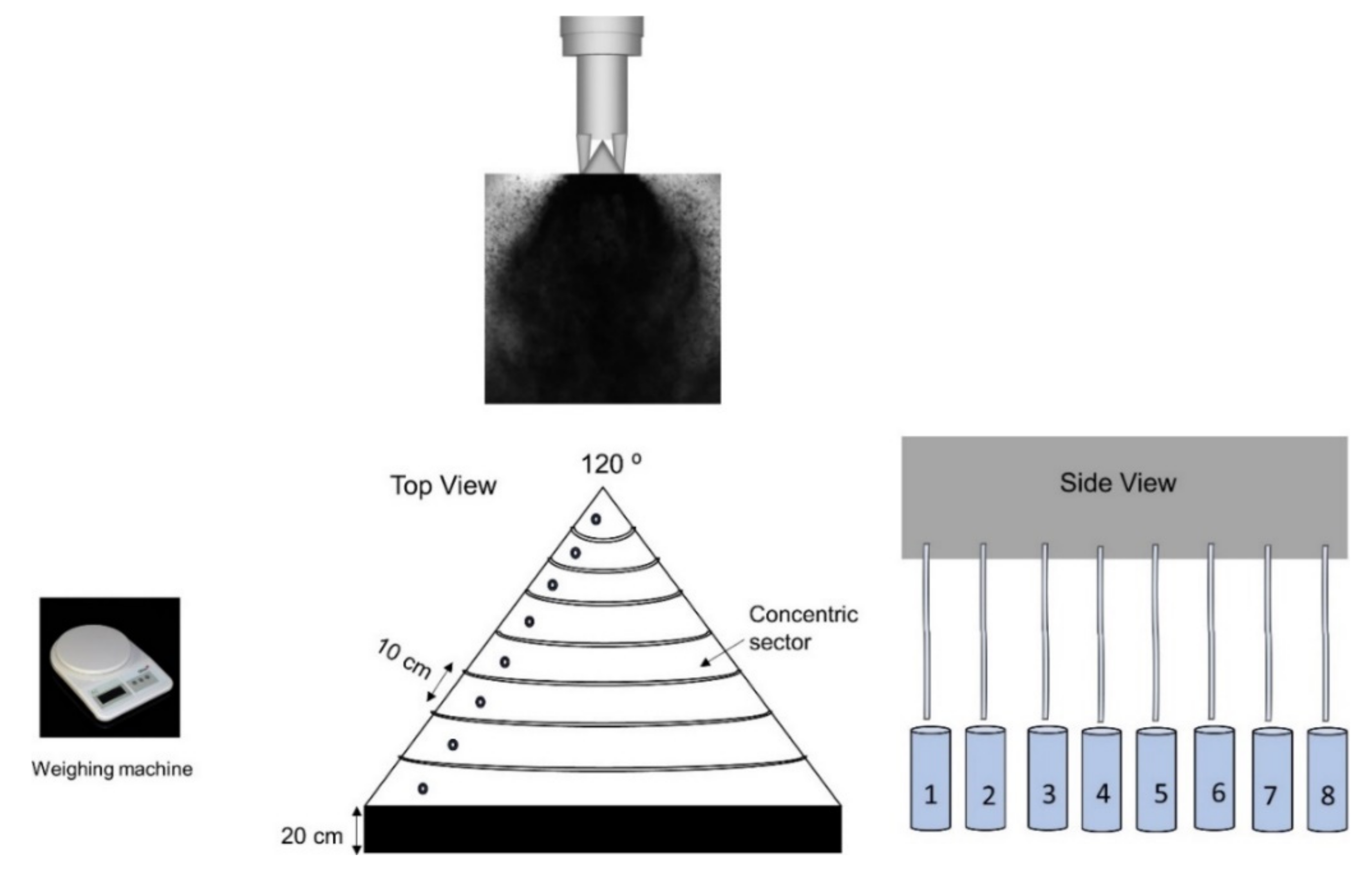
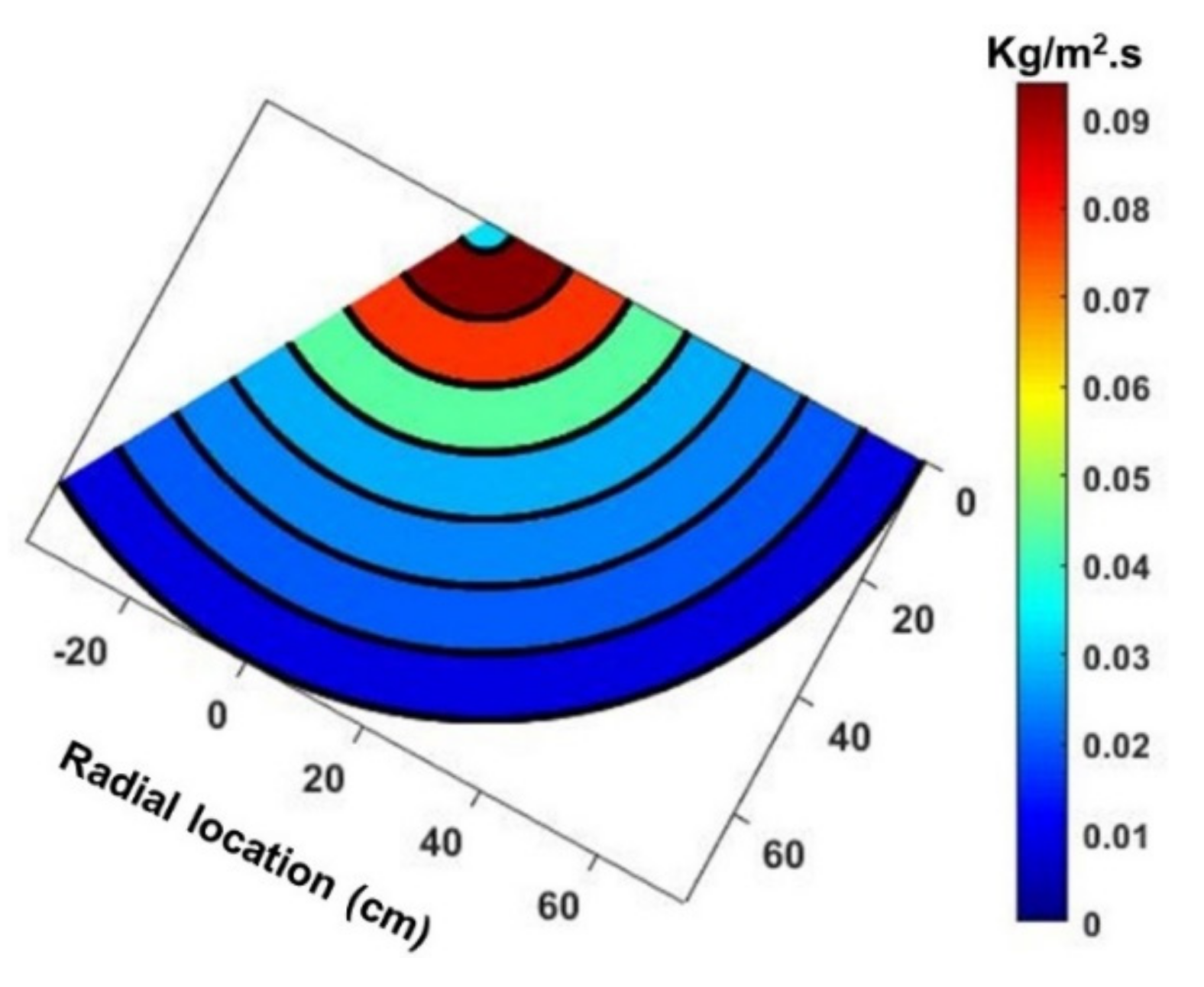
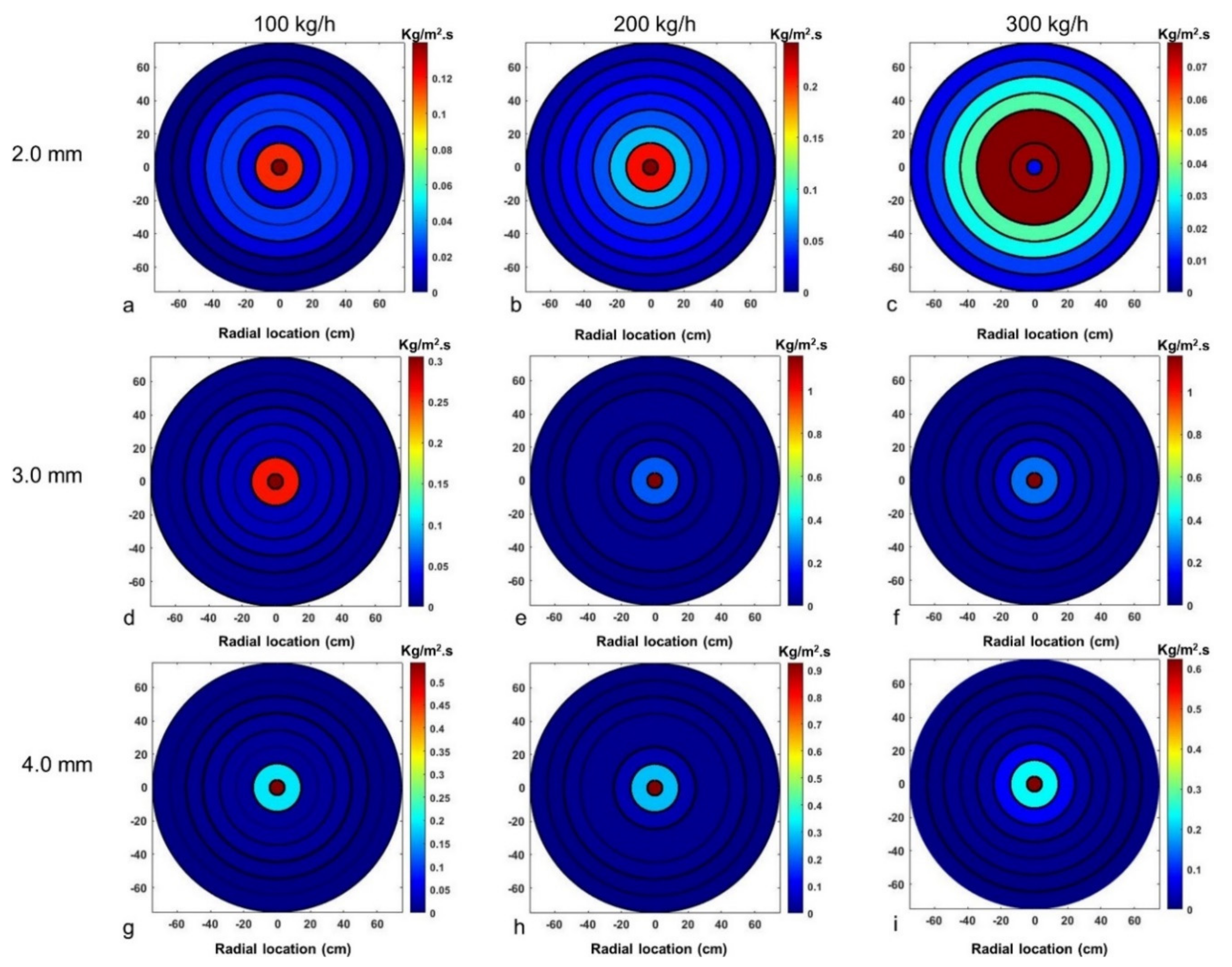
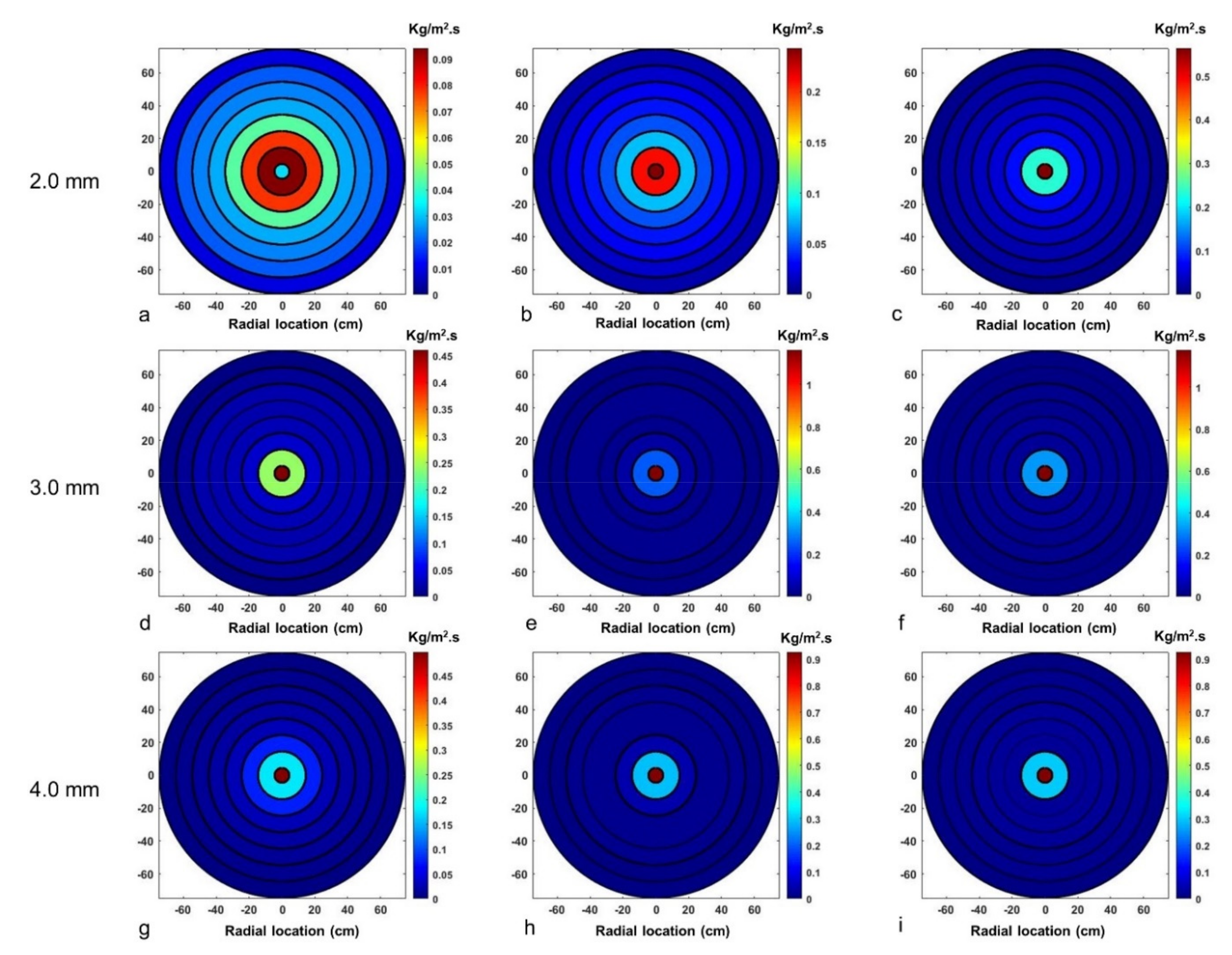
| Atomizer Type (mm) | Area-Throat Area Ratio (A/A *) | Mach Number (Mdesign) | Pressure * (P0 Design) | Operational Mach Number Range (M) | Operational Pressure * Range (P0) |
|---|---|---|---|---|---|
| 2.0 | 3.0 | 2.63 | 21.1 | 1.25−1.87 | 2.60−6.45 |
| 3.0 | 2.0 | 2.20 | 10.6 | 1.28−1.86 | 2.70−6.35 |
| 4.0 | 1.5 | 1.85 | 6.24 | 1.13−1.59 | 2.32−4.83 |
| Atomizer Type (d) | Liquid Flow Rate * | Airflow Rate * | ALR |
|---|---|---|---|
| 2.0 mm | 100 | 10 | 0.1 |
| 100 | 15 | 0.15 | |
| 100 | 20 | 0.2 | |
| 200 | 10 | 0.05 | |
| 200 | 15 | 0.075 | |
| 200 | 20 | 0.1 | |
| 300 | 10 | 0.033 | |
| 300 | 15 | 0.05 | |
| 300 | 20 | 0.066 | |
| 3.0 mm | 100 | 20 | 0.2 |
| 100 | 30 | 0.3 | |
| 100 | 40 | 0.4 | |
| 200 | 20 | 0.1 | |
| 200 | 30 | 0.15 | |
| 200 | 40 | 0.2 | |
| 300 | 20 | 0.066 | |
| 300 | 30 | 0.1 | |
| 300 | 40 | 0.133 | |
| 4.0 mm | 100 | 30 | 0.3 |
| 100 | 40 | 0.4 | |
| 100 | 50 | 0.5 | |
| 200 | 30 | 0.15 | |
| 200 | 40 | 0.2 | |
| 200 | 50 | 0.25 | |
| 300 | 30 | 0.1 | |
| 300 | 40 | 0.133 | |
| 300 | 50 | 0.166 |
| Parameters | Value |
|---|---|
| Normalization radius | 75 pixels |
| Reduce pixel noise | weak |
| Binarization threshold | 50% |
| Minimum slope | 3% |
| Minimum shadow area | 3 pixels |
Publisher’s Note: MDPI stays neutral with regard to jurisdictional claims in published maps and institutional affiliations. |
© 2022 by the authors. Licensee MDPI, Basel, Switzerland. This article is an open access article distributed under the terms and conditions of the Creative Commons Attribution (CC BY) license (https://creativecommons.org/licenses/by/4.0/).
Share and Cite
Sikka, R.; Vågsæther, K.; Bjerketvedt, D.; Lundberg, J. Experimental Investigation on the Spray Behaviour of Bluff Body Air-Assisted Atomizer Designs. Fluids 2022, 7, 301. https://doi.org/10.3390/fluids7090301
Sikka R, Vågsæther K, Bjerketvedt D, Lundberg J. Experimental Investigation on the Spray Behaviour of Bluff Body Air-Assisted Atomizer Designs. Fluids. 2022; 7(9):301. https://doi.org/10.3390/fluids7090301
Chicago/Turabian StyleSikka, Raghav, Knut Vågsæther, Dag Bjerketvedt, and Joachim Lundberg. 2022. "Experimental Investigation on the Spray Behaviour of Bluff Body Air-Assisted Atomizer Designs" Fluids 7, no. 9: 301. https://doi.org/10.3390/fluids7090301
APA StyleSikka, R., Vågsæther, K., Bjerketvedt, D., & Lundberg, J. (2022). Experimental Investigation on the Spray Behaviour of Bluff Body Air-Assisted Atomizer Designs. Fluids, 7(9), 301. https://doi.org/10.3390/fluids7090301







